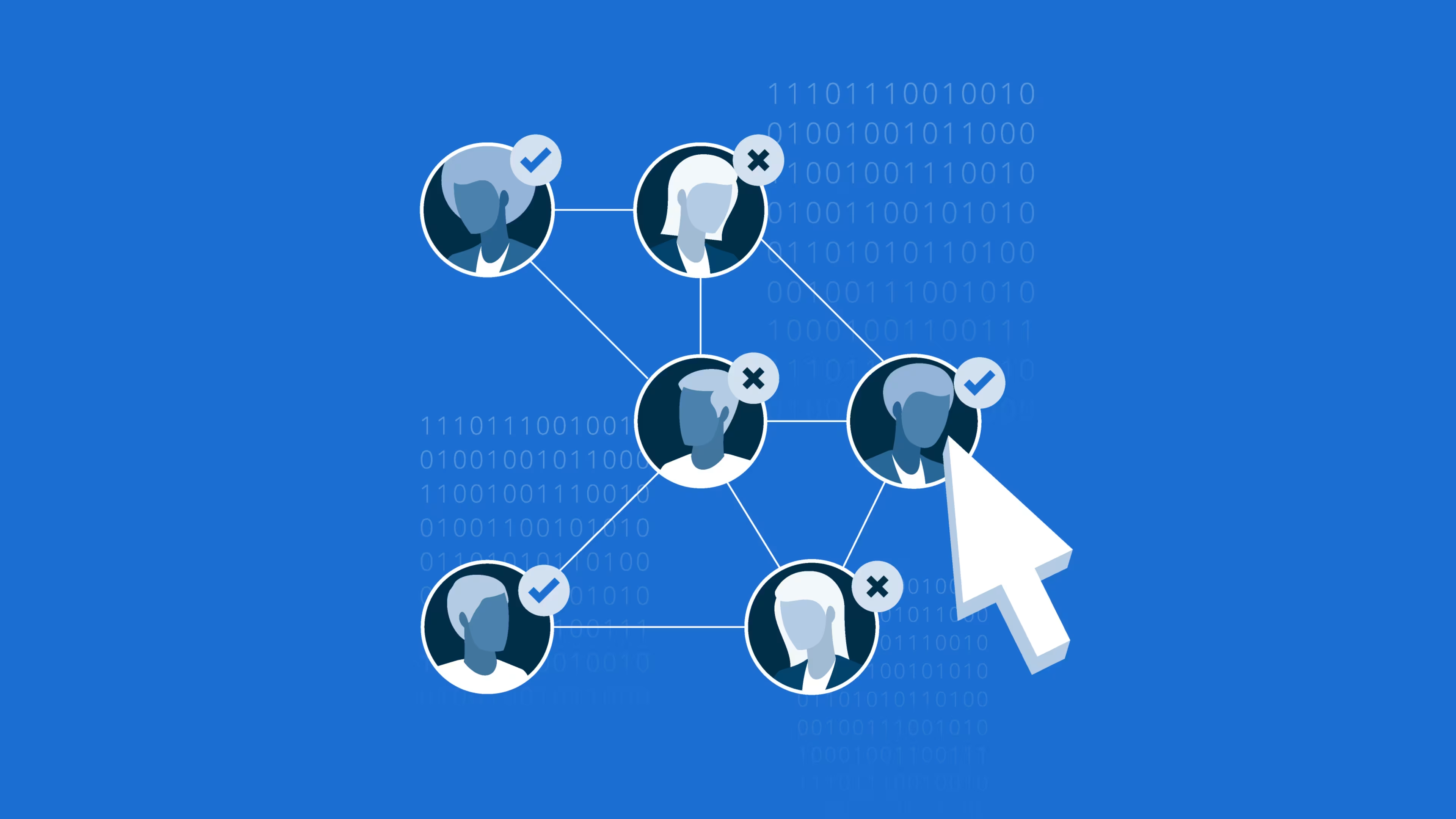Nearly all HR leaders say their department will use software and algorithms to reduce labor costs in a 2023 recession, but only half are completely confident their tech will produce unbiased recommendations.
Entering 2023, the dreaded "R" word—recession—is top of mind for companies around the country. In a Capterra survey of 300 HR leaders in the U.S., 72% say their employer has already started preparing for a possible recession, while 24% plan to start preparing soon.*
As in previous economic downturns, organizations will need to figure out ways to reduce labor costs, including deciding which employees to lay off if it comes to that. Where 2023 differs is that HR is both more strategically involved in these high-level labor decisions and more data-driven than ever before, supported by cutting-edge HR software systems that can aggregate massive amounts of employee information and turn it into actionable insights and recommendations.
A recession will be the biggest test of HR’s data-doting ways to date, yet our survey reveals that HR leaders are unsure if their technology is up to the task with such consequential decisions on the line.
While 98% of surveyed HR leaders say they'll rely on software and algorithms to reduce labor costs in a 2023 recession, only 50% of those leaders are completely confident their tech will make unbiased recommendations. And less than half (47%) are entirely comfortable making layoff decisions based on recommendations from that same tech.
Leveraged in the right way, data analytics and algorithms built into HR software can uncover useful insights that can’t be found through instinct or intuition alone—giving HR departments a significant advantage in making the best long-term decisions for their business in tough times. Use bad data, the wrong data, or have a poor understanding of how that data is used, however, and HR departments are all but guaranteed to get suboptimal recommendations from their technology.
In this report, we’ll analyze our survey results to understand how HR departments will leverage data and technology in the next recession, and offer tips on how HR leaders can ensure their tools are working for them and not against them when difficult decisions need to be made.
/ Key findings
HR veterans predict a 2023 recession will be disastrous: 48% of HR leaders who worked in HR during the Great Recession (2007-09) believe a 2023 recession will be worse. 27% think it will be better, and 25% think it will be about the same.
The “gut instinct” HR department is on its way out: More than 1 in 3 (35%) HR leaders will rely mostly or solely on data to come up with recommendations to reduce labor costs in a 2023 recession, compared to 1 in 5 (20%) that will rely mostly or solely on gut instinct.
Confidence in employee data is lacking: Only 41% of HR leaders using data in recession decision-making are completely confident their department has enough accurate data and sufficient data analysis skills to make good recommendations for reducing labor costs.
HR leaders aren’t completely comfortable relying on tech to make layoff decisions: Of the 98% of HR leaders whose departments will use software and algorithms to reduce labor costs in a 2023 recession, only 47% are completely comfortable making employee layoff decisions based on recommendations from their technology.
With a recession on its way, HR will look to data and software to weather the storm
While 2022 gave mixed signals regarding the health of the U.S. economy (GDP briefly declined, but the job market remained red hot), experts agree 2023 will be more clear-cut—and not in a good way. Model projections by Bloomberg peg the likelihood of a full-on recession hitting the U.S. by October 2023 at 100%.[1]
Asked how a recession will affect them, 75% of surveyed HR leaders say a recession will negatively impact their employer. For added context, we asked the HR leaders in our survey who worked in HR during the Great Recession of 2007-09 how they think a 2023 recession will compare. Nearly twice as many said a 2023 recession will be worse (48%) than better (27%).
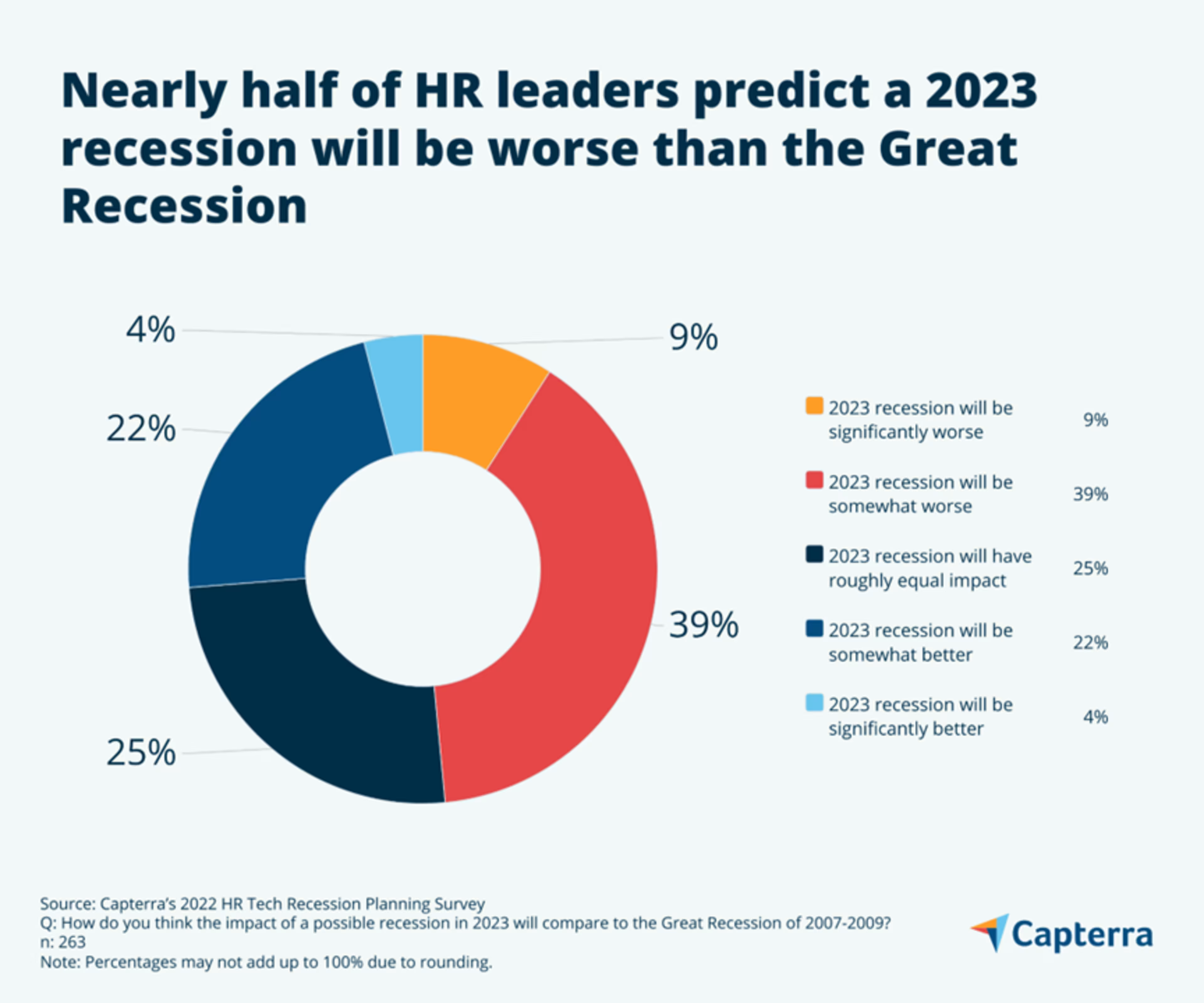
The outlook is dire, but HR’s role in the next recession will differ from its role in the Great Recession in two critical ways:
HR is now seen as a strategic partner, rather than just a back-office service provider. When companies opted to cut benefits or lay off employees in 2007, HR mostly executed on these decisions without participating in them. But in a 2023 recession, 92% of HR leaders in our survey say their department will play a significant role in deciding which cost-cutting measures to take as a business.
Today’s HR department is vastly more tech-enabled than it was 15 years ago. In 2008, Gartner estimated that only two percent of enterprise-level businesses had deployed a Software-as-a-Service (SaaS) solution for their core HR needs.[2] Today, HR departments at businesses large and small use a variety of SaaS solutions to define processes, automate tasks, and—most importantly—gather and analyze data.
Data and algorithms are replacing gut instinct
With a bigger seat at the leadership table and more advanced tools at their disposal, our survey finds that the HR department of old that relied on manual methods and intuition is being phased out.
Ninety-eight percent of HR leaders say their department will at least somewhat rely on HR software and algorithms to come up with recommendations to reduce labor costs in a 2023 recession. Additionally, more than one in three (35%) HR leaders say their department will rely mostly or solely on data to come up with their recommendations, compared to one in five (20%) who say their department will rely mostly or solely on gut instinct.
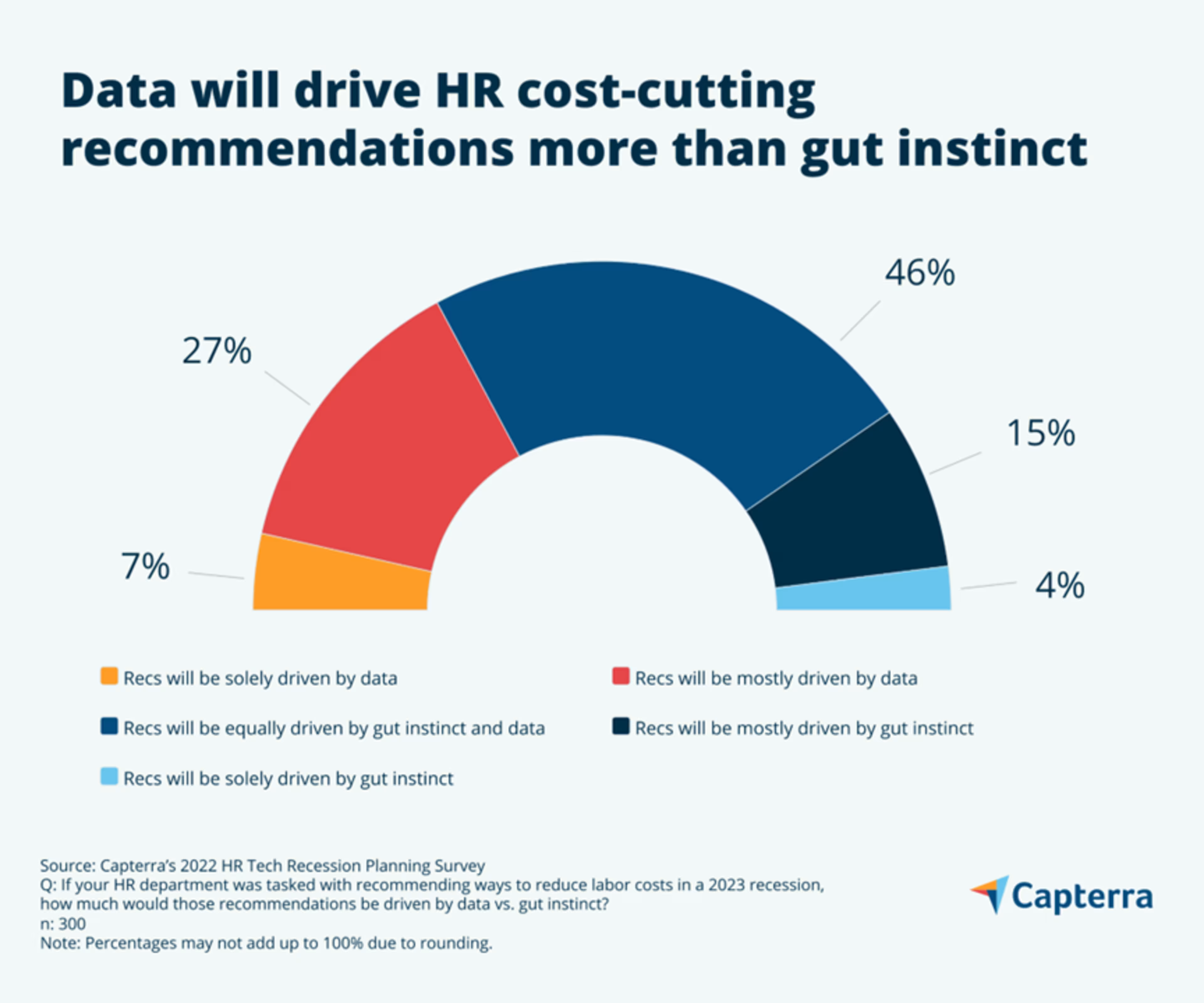
As Gartner points out, using data to drive recession decision-making is the right move for a number of reasons. It can help HR departments make decisions based on evidence instead of unconscious biases and fear, bolster explanations of why a particular decision was made, and make recommendations to executives about necessary talent actions more compelling.[3]
That being said, HR leaders need to proceed with caution. As we’ll demonstrate in the next section, using data and algorithms in the wrong way can lead to disastrous mistakes that you can’t afford to make with employees’ livelihoods and the future of the company at stake.
Should algorithms influence critical recession decisions? HR leaders are skeptical
To reduce labor costs, do you cut from learning and development (L&D), recruiting, or benefits? If you have to lay off employees, how many? And who? HR departments are keen on being data-driven to make these important decisions in a 2023 recession, but approaches will vary depending on the sophistication of their software tools and how hands-on or hands-off they want to be with their analysis.
The most basic approach is through the use of descriptive analytics, where HR departments look at historical data accrued in their HR software systems and make cost-cutting recommendations based on that data. For example, a department might see that L&D costs have gone up in each of the past three years and recommend cutting back on their L&D budget when the recession hits.
With descriptive analytics, HR departments are largely on their own to analyze trends and make decisions, and our survey shows they aren’t confident they’re up to the task. Of the 96% of HR leaders planning to use data in recession decision-making, only 41% say they are completely confident their department has both enough accurate data and sufficient data analysis skills to make good recommendations for reducing labor costs. Among HR leaders at small businesses (250 or fewer employees), that figure drops to 25%.
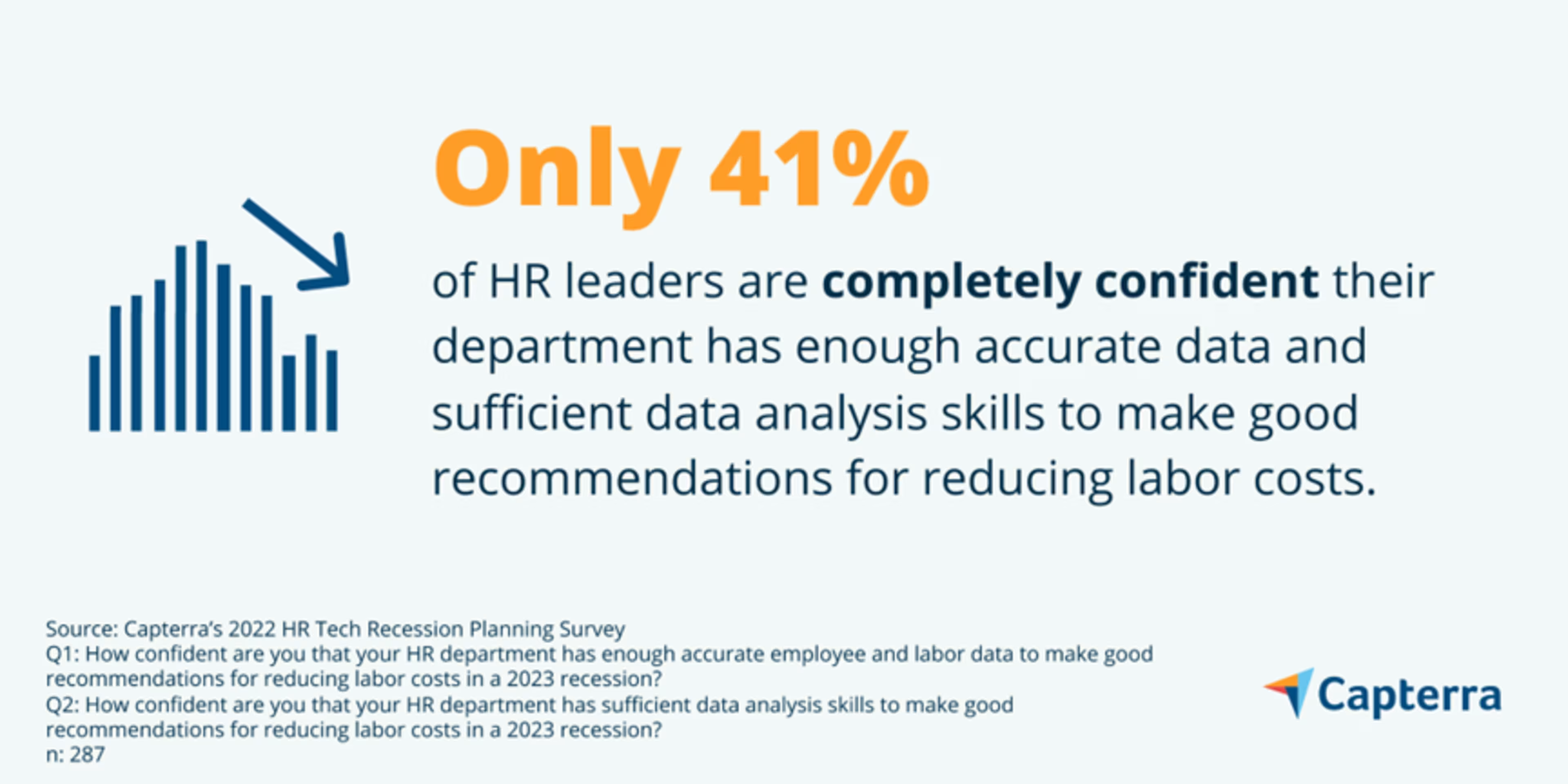
HR leaders lack confidence that they can analyze data on their own, but with the right technology they won’t have to. HR software with predictive analytics uses statistics and algorithms to predict future outcomes based on historical data. Systems with prescriptive analytics go even further, using sophisticated algorithms, data modeling, and artificial intelligence (AI) to actually recommend the best course of action based on predicted outcomes. HR departments merely need to provide the data, and the technology will do the rest.
The demand for so-called decision automation is growing rapidly. In a 2022 Gartner poll, 69% of participants indicated some of their decision making is, or soon will be, automated.[4]
But with such high stakes at play during a recession, HR isn’t quite ready to fully hand over every decision to an algorithm. Of the 98% of HR leaders in our survey who say their department will rely on software and algorithms to reduce labor costs in a 2023 recession, only 50% are completely confident that their tech will produce unbiased recommendations. And even less (47%) are completely comfortable making employee layoff decisions based on recommendations from HR software and algorithms.
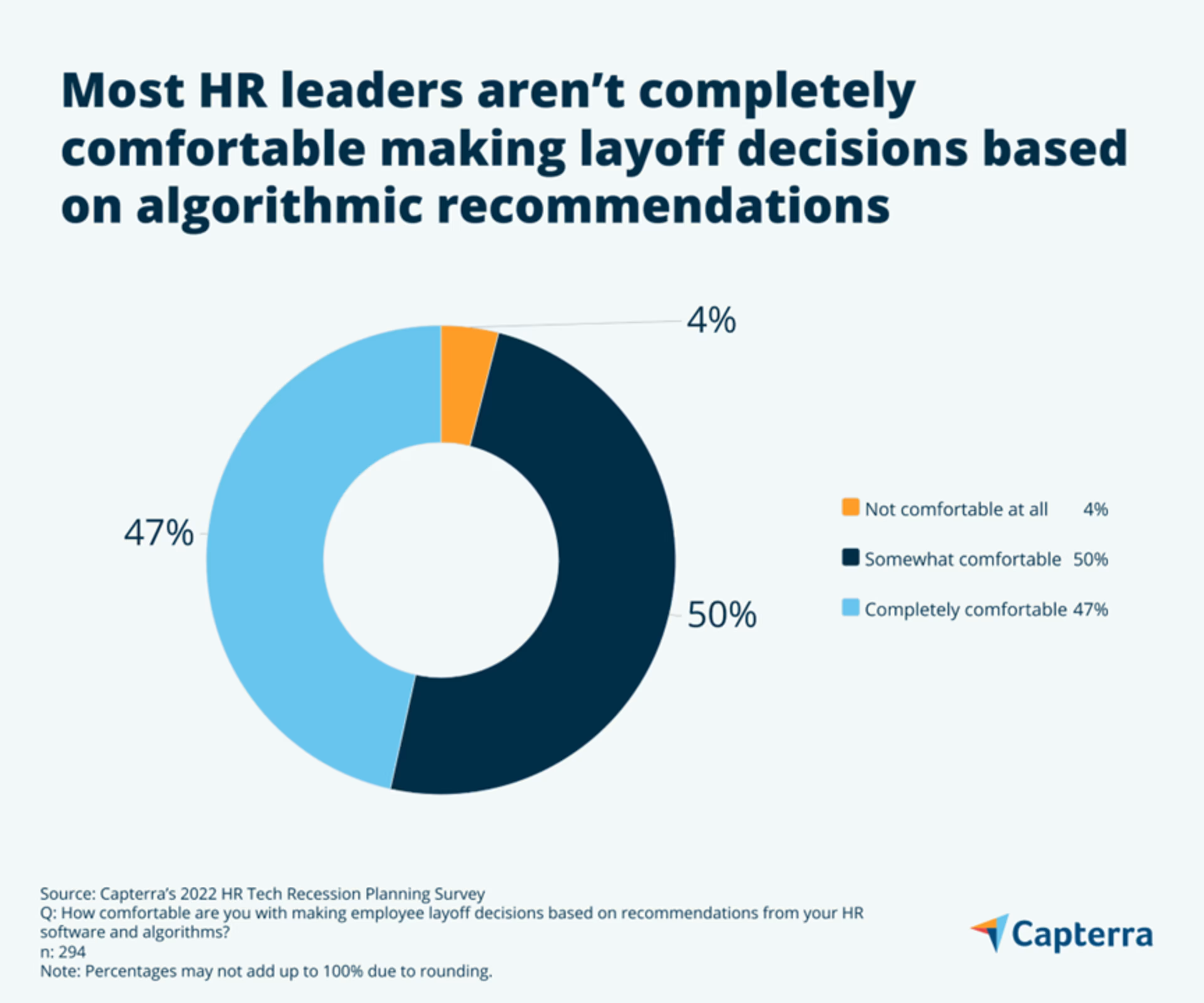
Why the hesitancy? For one thing, these advanced decision-making systems need a lot of data to make accurate recommendations. Many HR departments, especially at small businesses, simply don't have enough labor data to work with.
But even those with large amounts of accurate data can get bad recommendations from their software if they aren’t careful.
Here’s an example: Say an HR department has to lay off employees for the business to stay afloat, and decide they’ll use performance data to drive their decision. (This isn’t some hypothetical. When asked what employee data they would use to make layoff decisions in a 2023 recession, 70% of HR leaders in our survey said they would use performance data. Only skills data (71%) was cited more.)
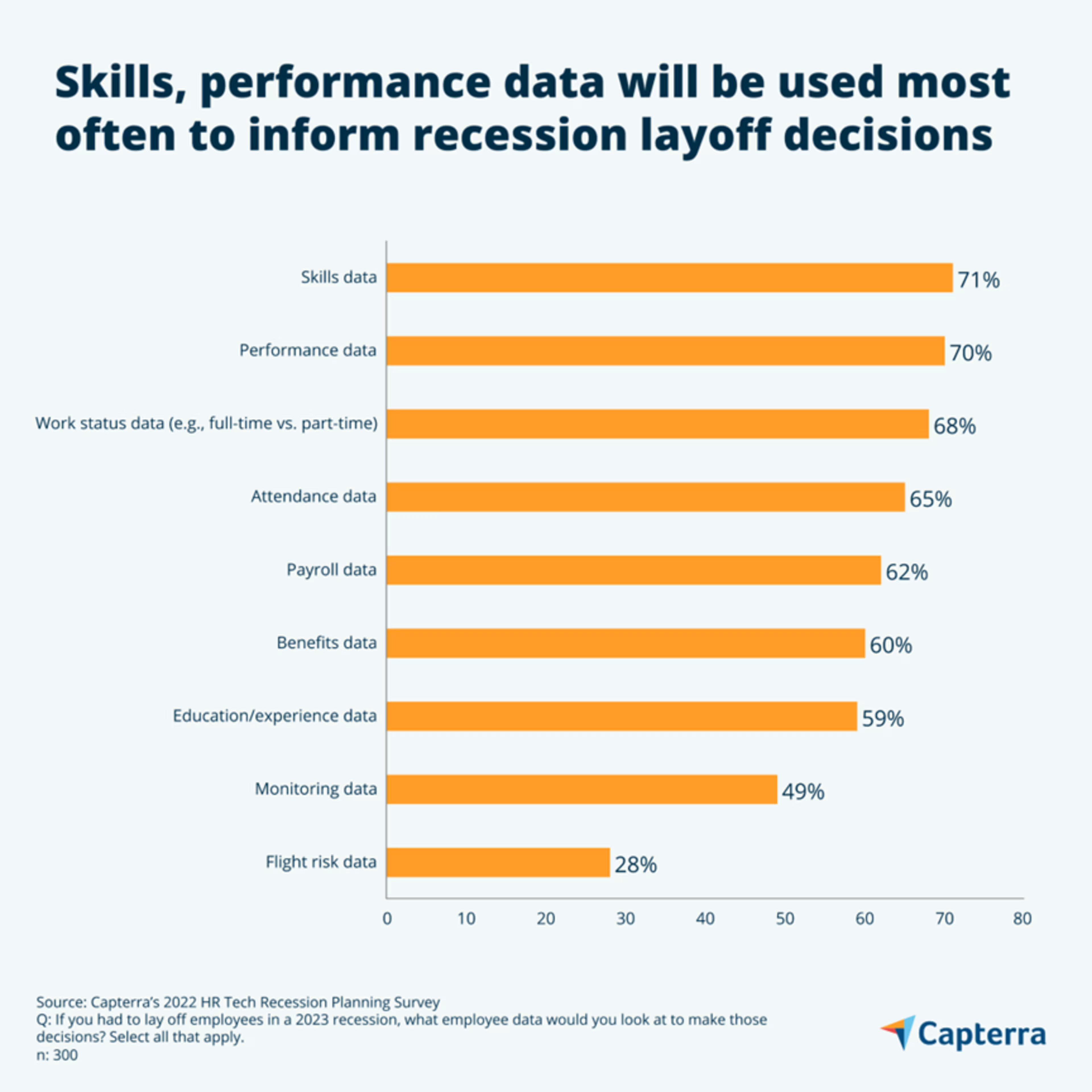
With prescriptive analytics, HR departments only need to feed their performance data into the system, give parameters on their desired result (such as how many employees to lay off), and the software will do the rest. But by HR’s own admission, their performance evaluation processes need an overhaul. A Gartner poll of HR leaders in 2020 found that 87% of HR leaders were considering changes to performance reviews.[5]
Is it possible a poor performance grade actually means an employee isn’t providing enough value to the organization, and should be a top candidate for being laid off? Sure. But it could also mean they have a biased manager, they lack adequate resources or support to work effectively, or the company simply isn’t tracking the right metrics to accurately evaluate employee performance. Algorithms aren’t able to take all of this context into consideration, resulting in poor recommendations.
Ultimately, it’s a true “damned if you do, damned if you don’t” situation for HR. Rely too much on instinct and intuition, or your own poor analytical skills, and you won’t arrive at the best cost-cutting decisions based on data and fact. Rely too much on analysis tools to make decisions for you, however, and your biased or inferior processes that produce the data being analyzed could come back to bite you.
5 best practices when using HR analytics software to aid decisions
Gartner confesses that decision automation in its current state is a dangerous game: “Without human intelligence and common sense, autonomous systems can quickly cause massive problems. Automated decisions may be inaccurate or unethical, or find other ways to go haywire.”[4]
Full decision automation won’t be viable for a large majority of HR departments in a recession, especially with such consequential decisions on the line. That being said, the value of HR analytics software to aid decision-making efforts can’t be overstated.
The right approach, combined with the right data and the right platform, can shed light on cost-cutting opportunities that you may not have found otherwise—which could allow your company to make it through the next economic downturn relatively unscathed.
If your HR department plans on using any data analytics tools during recession planning, here are five best practices to ensure they guide you in the right direction.
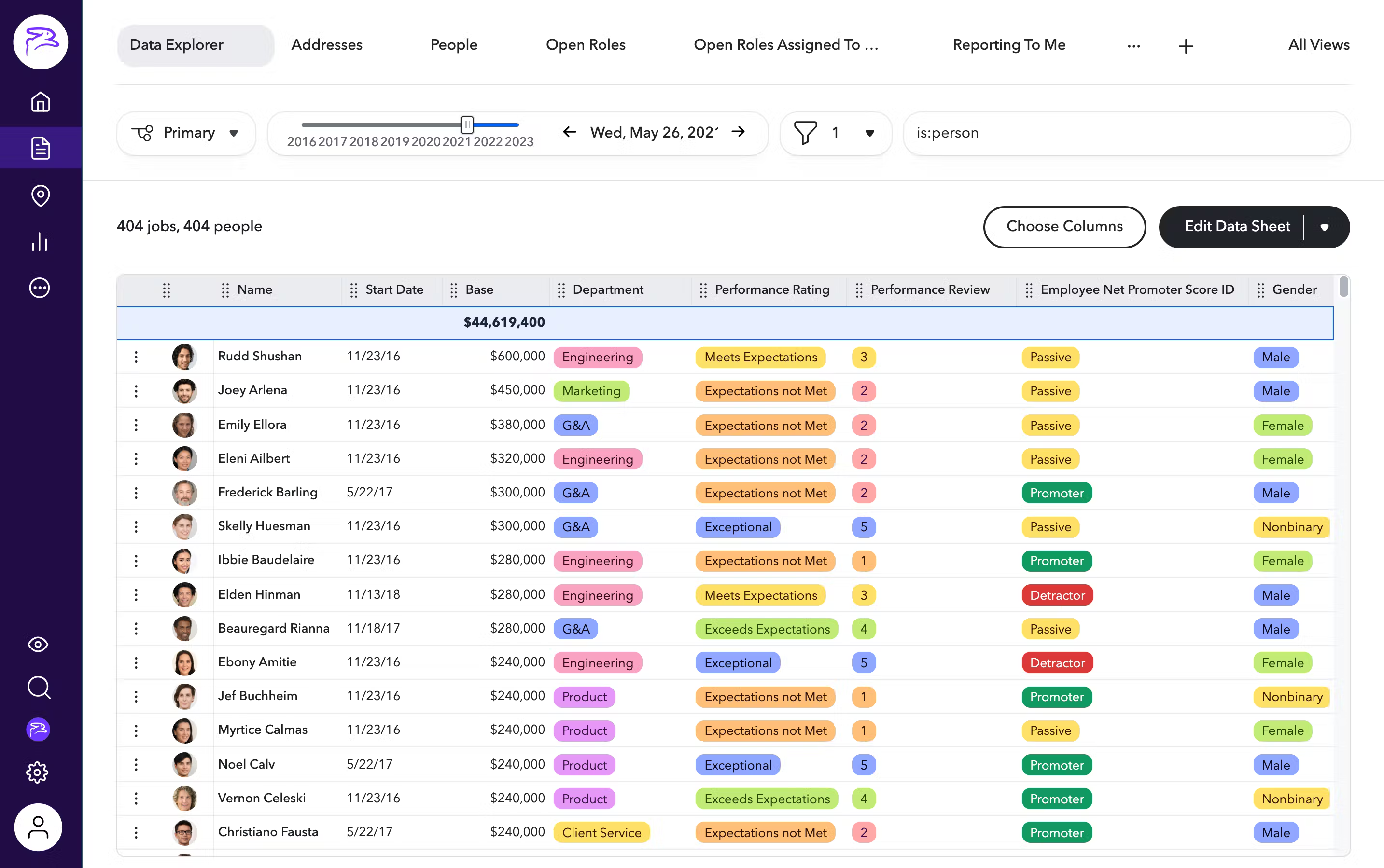
A data explorer dashboard in ChartHop (Source)
1. Carefully consider what data you’re going to use (and what data you can safely ignore)
In our performance data example earlier, we highlighted how many biases and external factors can contribute to someone being labeled a low performer. Contrast that with something like work status data: Either a worker is full-time or not, there isn’t much else to consider. Ideally, you should consider data that is more objective than subjective, and you should definitely ignore protected class data (race, age, gender, etc.).
You also need to weigh short-term vs. long-term goals. Laying off employees based on salary instead of skills will save money now, but will cost a great deal when you’re trying to grow and thrive as a company on the other side of a recession.
2. Perform a data audit
Regardless of the system you use, incomplete or inaccurate data will hold it back every single time. Once you have an idea of what data sets you’re going to analyze, perform a data audit to ensure everything is as it should be. If you’ve never done a data audit before, don’t worry, we have a helpful guide for beginners right here.
3. Ask questions to better understand “black box” algorithms
A black box algorithm is one where the user cannot see how it works. They’re used often by software vendors to either protect intellectual property or simplify the experience for the end user. The problem is that these algorithms could be making biased or improperly weighted recommendations without you even knowing it.
If a tool you’re using offers up a recommendation without explaining how it arrived at that conclusion, talk to your vendor to get as much information as possible about how the data sausage is made.
4. Explore out-of-the-box routes to the same result
If analysis reveals you have to cut employee hours, does that mean you should immediately turn to layoffs? Not necessarily. Some of your employees may actually appreciate the added flexibility of reduced hours or job sharing. Others may jump on the opportunity to retire early. Contractors can step in for tasks that would otherwise push a full-time employee into overtime.
The data may tell you there is only one option, but you should work with other department leaders to explore creative solutions that arrive at the same result.
5. Apply a healthy amount of skepticism
There’s a reason why only seven percent of HR leaders in our survey are cutting gut instinct out of their recession decision-making altogether. As much as we’ve talked about HR departments becoming more data-driven and tech-savvy, there should always be a place for humans to make the final call in decisions about other humans.
If something about any tech-enabled recommendations doesn’t sit right with your department, discuss and explore why that is before making any final decisions.
If you want more help, we asked five HR experts back in 2019 to weigh in on how HR can prepare for the next recession. They offer some great advice that’s still relevant today. And if you’re looking for new HR analytics software, our Capterra Shortlist of the best HR analytics products (based on real user reviews) is where you want to be.
